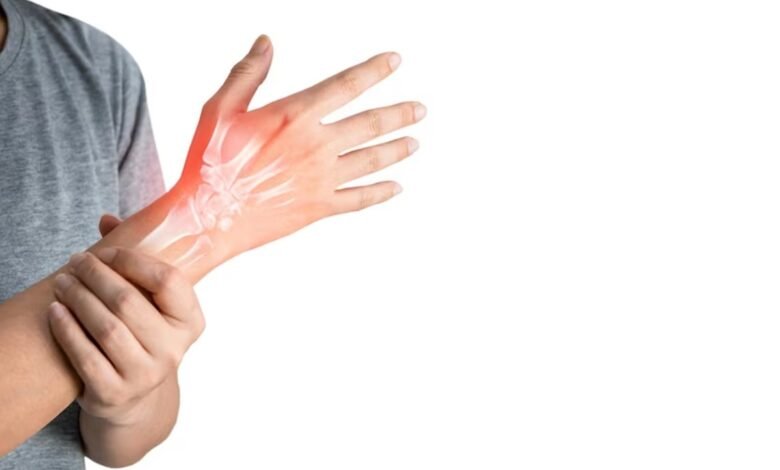What is Arthritis? Types, Causes, Symptoms, and Treatment

This comprehensive article will delve into arthritis, exploring its causes, symptoms, and the various treatment options available. Arthritis is a widespread condition affecting millions of people worldwide, and understanding its nuances is crucial for those dealing with it and their loved ones.
What is Arthritis
Arthritis is a term used to describe a group of over 100 different conditions that affect the joints in the body. It is not a single disease but a collection of disorders that cause joint inflammation, pain, and stiffness. Arthritis can affect people of all ages, genders, and backgrounds, and it is a leading cause of disability worldwide.
Types of Arthritis
Osteoarthritis (OA)
What is Arthritis: Osteoarthritis is the most common type of arthritis and primarily affects the cartilage, the protective tissue covering the ends of bones in the joint. Over time, this cartilage can wear down, leading to pain and stiffness.
Read More: Managing Arthritis and Rheumatology: Tips for a Pain-Free Life
Rheumatoid Arthritis (RA)
Rheumatoid arthritis is an autoimmune disorder where the body’s immune system mistakenly attacks the joints, causing inflammation, pain, and potentially joint damage.
Psoriatic Arthritis
Psoriatic arthritis often accompanies psoriasis and can affect the skin and joints, causing swelling, pain, and nail changes.
Ankylosing Spondylitis
Ankylosing spondylitis primarily impacts the spine and pelvis, causing inflammation in the vertebrae, which can lead to fusion and limited mobility.
Causes of Arthritis
What is Arthritis: Arthritis can be attributed to various factors, and understanding these causes is essential for effective management. The primary factors contributing to arthritis include:
Genetics
A family history of arthritis can increase an individual’s susceptibility to developing the condition. Certain genetic markers may predispose someone to specific types of arthritis.
Age
The risk of arthritis tends to escalate with age. Osteoarthritis, in particular, becomes more common as individuals grow older. However, arthritis can affect people of all age groups, including children.
Joint Injuries
Previous joint injuries, trauma, or overuse can contribute to arthritis in specific joints. Such injuries may disrupt the normal functioning of the joint and lead to long-term damage.
Autoimmune Factors
Autoimmune diseases, where the body’s immune system mistakenly attacks its tissues, can play a role in developing conditions like rheumatoid arthritis (RA). In RA, the immune system targets the synovium, a lining around the joints, causing inflammation and damage.
Understanding these underlying causes can aid in preventing and managing arthritis. Consulting a healthcare professional for a precise diagnosis and tailored treatment plan is crucial.
Common Symptoms
What is Arthritis: Arthritis presents a range of symptoms, such as:
Joint Pain
Pain in one or more joints is a hallmark symptom of arthritis.
Stiffness
Joint stiffness, especially in the morning, is common among people with arthritis.
Swelling
Inflammation can cause joints to swell and become tender.
Reduced Range of Motion
Arthritis can limit your ability to move joints through their full range of motion.
Diagnosing Arthritis
What is Arthritis: Accurate diagnosis is crucial for effectively managing arthritis. Healthcare professionals use various methods to diagnose this condition, including:
Medical History
Discussing your medical history and symptoms with your healthcare provider is the initial step in the diagnosis process. Be sure to provide detailed information about the location, duration, and intensity of your joint pain and any associated symptoms.
Physical Examination
A thorough physical examination of the affected joints follows the discussion of your medical history. During this examination, the healthcare provider assesses the joints for signs of swelling, tenderness, warmth, and limited range of motion. They may also look for joint deformities.
Imaging Tests
Imaging tests, such as X-rays, magnetic resonance imaging (MRI), and computed tomography (CT) scans, can provide detailed images of the affected joints. These images can reveal joint damage, cartilage loss, and the extent of inflammation.
Blood Tests
Blood tests can help identify specific types of arthritis, particularly autoimmune forms like rheumatoid arthritis (RA). Tests may detect the presence of certain antibodies and inflammatory markers in the blood.
These diagnostic methods enable healthcare professionals to determine the type of arthritis, its severity, and the appropriate treatment plan. Early diagnosis and intervention are essential in managing arthritis effectively.
Arthritis Treatment Options
What is Arthritis: Treating arthritis aims to alleviate pain, reduce inflammation, and improve joint function. The treatment choice depends on the type of arthritis, its severity, and the individual’s unique needs. Here are various treatment options for arthritis:
Medications
Pain Relievers: Over-the-counter pain relievers like paracetamol can help manage mild to moderate arthritis pain.
Nonsteroidal Anti-Inflammatory Drugs (NSAIDs): These drugs, available over-the-counter and by prescription, reduce pain and inflammation. Examples include ibuprofen and naproxen.
Disease-Modifying Antirheumatic Drugs (DMARDs): DMARDs are primarily used to treat autoimmune arthritis like rheumatoid arthritis. They slow down the progression of the disease by suppressing the immune system’s abnormal response.
Biologics: Biologic medications are a subset of DMARDs that target specific molecules in the immune system to reduce inflammation and halt joint damage.
Physical Therapy
What is Arthritis: Physical therapists can design exercise routines and techniques to improve joint flexibility, strength, and mobility. These exercises can alleviate pain and help individuals regain functionality.
Lifestyle Changes
Weight Management: Maintaining a healthy weight reduces the strain on joints, especially in weight-bearing joints like the knees and hips.
Diet: Certain foods can exacerbate inflammation, while others have anti-inflammatory properties. A balanced diet of fruits, vegetables, and omega-3 fatty acids can help manage symptoms.
Physical Activity: Regular, low-impact exercise like swimming or walking can strengthen muscles around the joints, providing better support.
Surgical Interventions
What is Arthritis: In severe cases, when conservative treatments are insufficient, surgical options may be considered:
Joint Repair: Procedures like arthroscopy can be used to repair damaged joints, particularly in cases of injury-related arthritis.
Joint Replacement: Total joint replacement, such as hip or knee replacement, may be necessary to replace severely damaged joints.
Pain Management
What is Arthritis: Managing arthritis-related pain is essential:
Pain Medications: Prescription medications can be used when over-the-counter options are insufficient.
Heat and Cold Therapy: Applying heat or cold packs to affected joints can relieve pain and inflammation.
Assistive Devices: Braces, splints, or orthopedic devices can support and protect affected joints.
Exercise: Regular physical activity, tailored to individual needs, can strengthen muscles and improve joint function.
Individuals with arthritis must work closely with their healthcare team to develop a comprehensive treatment plan that addresses their specific conditions and needs. Effective management can significantly enhance the quality of life of those with arthritis.
Pain Management
What is Arthritis: Managing arthritis-related pain includes:
Pain Medications
Prescription and over-the-counter pain relievers.
Heat and Cold Therapy
Applying heat or cold to affected joints for pain relief.
Assistive Devices
Braces, splints, and mobility aids can help reduce strain on joints.
Exercise
Regular physical activity can strengthen muscles and improve joint function.
Alternative Therapies
What is Arthritis: Some people explore alternative treatments like:
Acupuncture
The practice of inserting thin needles into specific points on the body for pain relief.
Herbal Supplements
Certain herbs may have anti-inflammatory properties.
Dietary Changes
A healthy diet rich in anti-inflammatory foods can help manage symptoms.
Mind-Body Practices
Techniques like meditation and yoga can promote relaxation and pain reduction.
Living with Arthritis
Coping Strategies
What is Arthritis: Developing coping mechanisms to deal with the emotional and physical challenges of arthritis.
Support Groups
Joining support groups can provide a sense of community and valuable information.
Dietary Considerations
Certain foods can exacerbate arthritis symptoms, while others can help alleviate them.
Emotional Well-being
Mental health is integral to managing arthritis. Seek support if needed.
Preventing Arthritis
What is Arthritis: Taking preventive measures can reduce your risk of developing arthritis:
Maintaining a Healthy Weight
Excess weight places strain on joints, particularly in the knees and hips.
Exercise Regularly
Regular physical activity can strengthen joints and muscles.
Protect Your Joints
Avoid activities that may increase the risk of joint injuries.
Stay Hydrated
Proper hydration is essential for joint health.
Arthritis Myths Debunked
What is Arthritis: Let’s debunk some common myths about arthritis:
Only Older People Get Arthritis
Arthritis can affect individuals of all ages, including children.
Cracking Your Knuckles Causes Arthritis
Research has not established a link between knuckle cracking and arthritis.
Arthritis Is Just Joint Pain
Arthritis encompasses various symptoms beyond joint pain.
There’s No Hope for Relief
Numerous treatment options are available to manage arthritis effectively.
Read More: Beating Rheumatoid Arthritis Chronic Fatigue
Conclusion
In conclusion, arthritis is a complex condition with various forms and causes. Understanding its intricacies is crucial for early diagnosis and effective management. Whether you are dealing with arthritis or supporting someone who is, knowledge is a powerful tool in the journey toward better joint health.
FAQs
Can arthritis be cured completely?
No, there is no known cure for arthritis, but many treatment options can effectively manage symptoms and improve the quality of life for individuals with arthritis.
Is there a link between diet and arthritis?
Yes, certain dietary choices can impact arthritis symptoms. A diet rich in anti-inflammatory foods can help reduce inflammation and pain.
What are the early signs of arthritis?
Early signs may include joint pain, stiffness, and swelling. If you suspect arthritis, consult a healthcare provider for a proper diagnosis.
Are there any natural remedies for arthritis?
Some individuals find relief from arthritis symptoms through natural remedies like herbal supplements and dietary changes, but it’s essential to consult a healthcare professional before trying alternative treatments.
Can young people develop arthritis?
Yes, arthritis can affect people of all ages, including children and young adults. Juvenile idiopathic arthritis is a specific condition that occurs in children.







